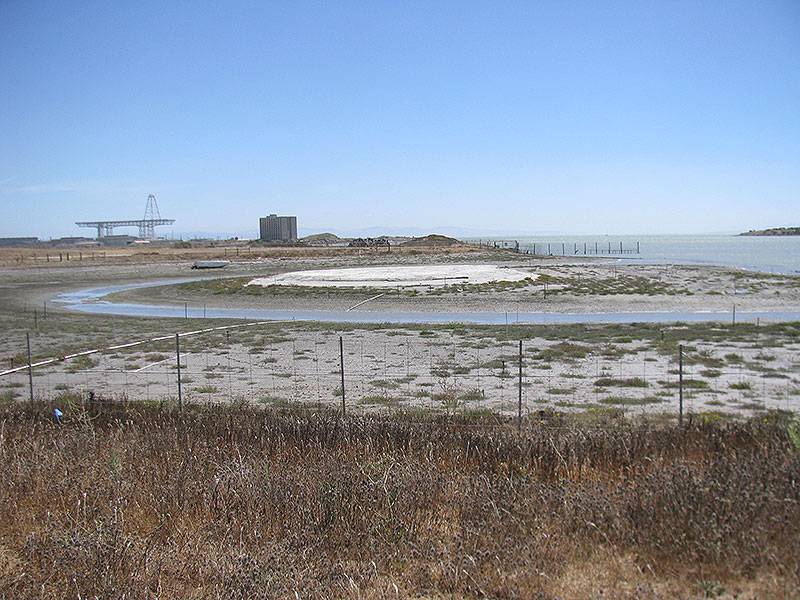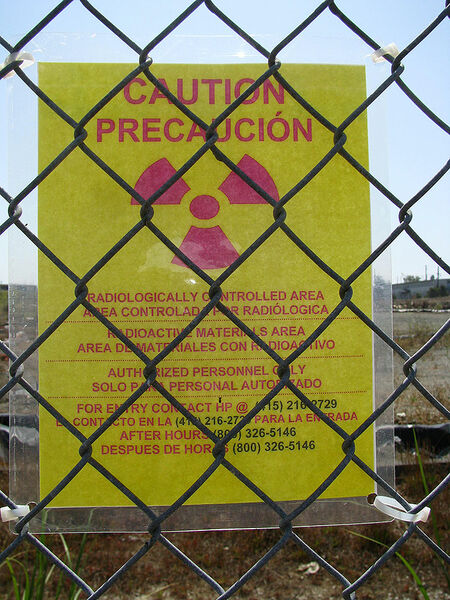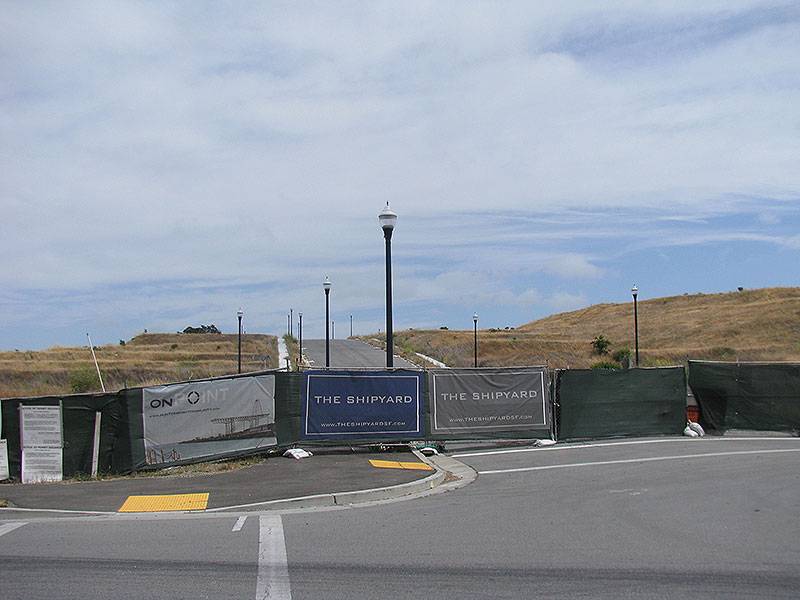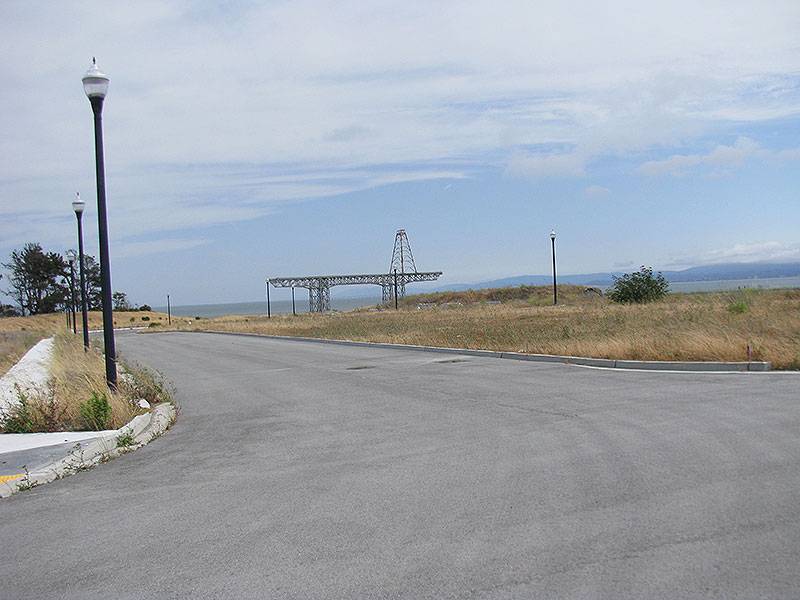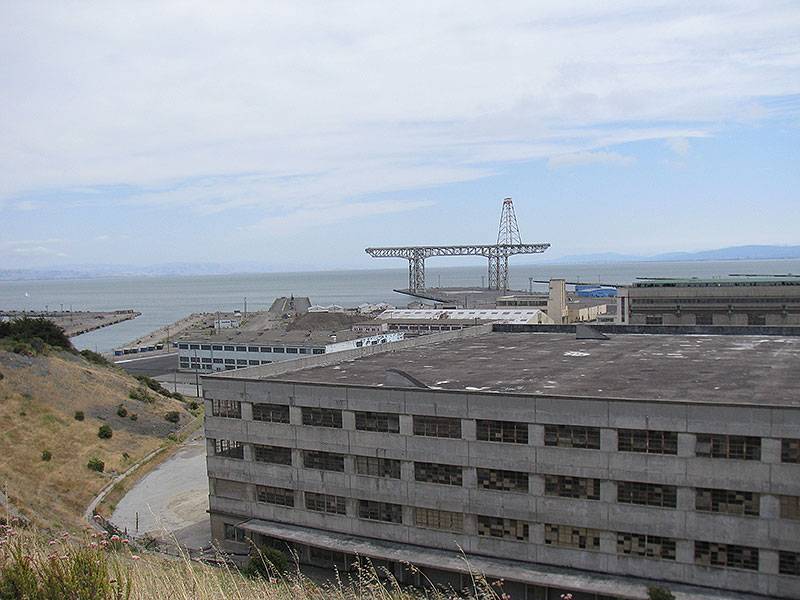Navy’s Own Complicity in the Historic Eco-Fraud Scandal at Hunters Point
Historical Essay
by Greg M. Schwartz
Originally published on Oct. 20, 2020, in the San Francisco Bayiew newspaper, republished here with permission.
View east across Parcel E, the most toxic area of the old shipyard.
Photo: Chris Carlsson, 2013
Determining where to assign blame at Hunters Point became even more complicated when it was learned that the Navy had exempted most of the shipyard from being tested for any radioactive contamination at all.
“That’s the big scandal here – it’s not just that what Tetra Tech did measure was fabricated. But the Navy exempted 90 percent of the shipyard from being tested in any fashion – and 90 percent of radionuclides they didn’t test for,” Daniel Hirsch of the Committee to Bridge the Gap (CBG) told the San Francisco Examiner. Focused on issues of nuclear safety, waste disposal, proliferation and disarmament, CBG is a non-profit organization that has issued several extensive reports exposing the flawed cleanup at Hunters Point. “With all those limitations, the irony is that Tetra Tech still had to fabricate 90 to 97 percent of its measurements.”
The retired director of the Environmental and Nuclear Policy program at the University of California-Santa Cruz is lead author of the CBG reports on Hunters Point and says that Tetra Tech’s explanation of rogue employees acting on their own “is not persuasive.” Hirsch points to how the federal contracting system sadly encourages companies to focus on saving the government money at the expense of best remediation techniques, so as to earn more contracts.
“This points to a much larger problem, which is that the Navy, DOE, NRC and Army Corps of Engineers, everyone is up to their eyeballs in failure to prevent and clean up radioactive contamination,” Hirsch points out.
Radioactivity sign along perimeter of former Naval Shipyard, 2009.
Photo: Chris Carlsson
Hirsch also notes how the Navy found much more contamination than they expected to on Parcel B and then altered the cleanup’s Record of Decision to cop out on dealing with it. “They changed the remedy from cleaning it up to covering it … to just leave most of the contamination there,” Hirsch says, summarizing his extensive documentation of the issue in CBG’s fourth report on Hunters Point that was issued in August of 2019. Hirsch added that merely covering the contamination is “a huge risk” because the developers are likely to wind up having to dig it up, during which the toxic soil will inevitably go up into the air.
“The Navy shifted course because it found that contamination was far more widespread and would be more expensive to clean up than it had initially assumed,” the report’s executive summary notes. The strategy to amend the Record of Decision from removing the toxic waste to merely covering it up is yet another play from the EPA’s playbook at the IEL in Ohio, where citizens were originally promised a full cleanup only to see the EPA revise the Record of Decision multiple times to wind up with putting a cap over the landfill instead of remediation.
The City of San Francisco meanwhile keeps plunging ahead into further potential liability, approving the construction of more homes at Hunters Point in the summer of 2019. This despite the ongoing litigation over the fraudulent cleanup and the troubling questions that remain about the Navy’s failure to remediate the site.
The housing on Parcel A has now been built by Lennar Corporation, dubbed ironically "The Shipyard" for marketing purposes.
Photo: Chris Carlsson
Before construction of houses began.
Photo: Chris Carlsson
Another potential conflict of interest at Hunters Point concerns the Battelle Memorial Institute, an allegedly “independent, third party” organization that has worked with the Navy for decades. The Columbus, Ohio-based Battelle helps manage six national laboratories for the DOE including Los Alamos National Lab (LANL) with Texas A&M University (the school denies that then-U.S. Energy Secretary Rick Perry had any involvement with the award of the contract to his alma mater despite his long record of cronyism).
The Navy contracted Battelle in 2010 to do a cost-cutting study to “optimize” the radiological work being done at Hunters Point by Tetra Tech. Battelle in turn contracted with the Argonne National Laboratory for a report – released in 2012 – that suggested changes to cleanup rules which would reduce costs by enabling the Navy to classify a larger amount of soil as not posing a potential risk. That’s what wound up happening at Hunters Point and the Trump regime’s DOE followed suit by brazenly moving to similarly reclassify nuclear waste nationwide. The Battelle/Argonne plan foreshadowed the Trump regime’s similar proposal to save billions of dollars and decades of cleanup work.
But while the Navy presented Argonne’s report as independent, the fine print revealed that it didn’t actually represent the independent assessment of Argonne since it was “prepared as an account of work sponsored by Battelle Memorial Institute.” And to close the loop, Argonne’s work further relied on data that was provided by Tetra Tech and vetted by the Navy. Battelle additionally employed the Tetra Tech subsidiary Tetra Tech NUS as a subcontractor on an $100 million environmental contract with the Navy. A Battelle spokesperson attempted to dismiss this potential conflict of interest, telling the San Francisco Chronicle that Tetra Tech NUS wasn’t involved with the issues at Hunters Point.
Tetra Tech spin managers have similarly attempted to split hairs regarding the company’s $250 million contract from CalRecycle for cleanup of 2018’s devastating Camp Fire in Northern California. Tetra Tech’s Sam Singer told Curbed SF, “The Butte County/Camp fire was awarded to Tetra Tech, Inc., which is the parent company of and a separate corporation from Tetra Tech EC, Inc.” He went on to rationalize that “Tetra Tech, Inc. never performed any work at Hunters Point Naval Shipyard, and Tetra Tech EC will not perform any work related to the Camp Fire.”
Curiously, the Navy chose Battelle as the so-called “independent” contractor to oversee work by Jacobs Engineering Group, a firm hired to resurvey buildings at Hunters Point that Tetra Tech had cleared as safe from radiation. And Tetra Tech has now further muddied the situation with their lawsuit suing five competitors (including Battelle and Jacobs’ acquisition CH2M) for allegedly “using unscientific criteria” in their review of Tetra Tech’s work at Hunters Point.
The Bay Area’s Greenaction for Health and Environmental Justice tried to go around the Navy and the EPA by filing their petition with the NRC in 2017 that sought to have Tetra Tech’s license to handle radioactive materials revoked. The Project on Government Oversight (POGO) succinctly summed up the allegations in their Federal Contractor Misconduct Database:
“The petitioners allege Tetra Tech employees and its subcontractors engaged in at least six types of fraud: (1) fake sampling, in which potentially thousands of soil samples were reported to have been taken at one location when they were actually taken from another; (2) discarding samples and analytical results that were radiologically too ‘hot’; (3) altering scanning data to make them appear radiologically acceptable; (4) conducting false building surveys in which certain scan results were fabricated and falsified; (5) improperly remediating radioactive material; and (6) allowing potentially contaminated soil to be shipped offsite for commercial purposes.”
But after stalling for two years, the NRC continued to carry water for Tetra Tech by saying it would keep kicking the can down the road while waiting for the DOJ. “The NRC will defer its decision regarding your 2.206 Petition pending the outcome of the DOJ’s ongoing civil complaint against TTEC,” the commission wrote in December of 2019, shirking responsibility by citing a 1988 memorandum of understanding with the DOJ. The NRC then cited the same response in August of 2020 when the Environmental Law and Justice Clinic at the Golden Gate University School of Law sought another update.
“The NRC’s failure to take action in response to the alleged fraud is business as usual, where our government on local, state and federal levels protect rich corporations and not low income, working class and people of color communities that continued to be harmed by injustice and racism,” Greenaction Director Bradley Angel says, regarding the NRC’s deferment to the DOJ.
The EPA’s continuing use of Tetra Tech despite the troubling litigation against the company is typical of the governmental trend of privatizing the protection of public health. The EPA somehow managed to brush the Hunters Point fraud aside when it awarded Tetra Tech an $85 million contract in the fall of 2017 to assess uranium contamination at 30 abandoned mines on the Navajo Nation reservation.
“I do not use this rhetorically: It’s been a straight up coverup since the [Tetra Tech] whistleblowers started coming forward – from City Hall to the Navy and EPA and everybody in between, to the politicians – including Pelosi – ignoring what the whistleblowers were saying, as well as the developer, Lennar Corporation,” Greenaction’s Angel laments. “There needs to be an independent audit and investigation of potential corruption and improper relationships between San Francisco City Hall, state agencies and the feds, because something stinks about this and they have no shame. Communities are truly at risk and it’s a squandering of our tax dollars on top of that.”
The DOE meanwhile continues to employ Tetra Tech at Los Alamos National Laboratory (LANL) and other sites including design-build services for DOE’s National Nuclear Security Administration, despite warnings from Nuclear Watch that “serious allegations of fraud by Tetra Tech” had been raised long before the LANL cleanup contract was awarded to the company.
“This situation shines a light on the cozy DOE contractor system, where every cleanup site has different combinations of the same contractors. Call it different trees, but the same old monkeys, where the real priority is to profit off of taxpayers’ dollars before a shovel turns over any waste,” Nuclear Watch Research Director Scott Kovac told The Los Alamos Monitor in 2018.
Greenaction’s Angel further laments the disingenuous manner in which Tetra Tech has attempted to shelter their parent firm from the misdeeds of their subsidiaries.
“The various parts of Tetra Tech are connected to each other, and our government needs to hire contractors for toxic cleanup that have a good track record – not one connected to massive fraud that endangered public health and wasted hundreds of millions of taxpayer dollars at the Hunters Point Shipyard Superfund site. This stinks, but is business as usual,” Angel says regarding the award of the Camp Fire cleanup contract.
How independent was the UC academic panel that examined testing at Hunters Point?
A purportedly independent academic panel of scientific experts from the University of California that was enlisted by the City of San Francisco in 2019 to review current testing measures at Hunters Point deemed the most recent surface testing to be “appropriate as a health and safety survey,” in a report released this past January. But critics quickly alleged that the panel worked from a limited mandate that was inherently flawed by a reliance on previous data and a narrow framework.
“The committee just assumed the historical record is accurate but didn’t discuss whether the record should be relied on; they didn’t review any whistleblower testimony,” Greenaction organizer Sheridan Noelani Enomoto told Curbed SF.
Whistleblower attorney David Anton noted that the panelists chose not to contact former employees who knew how Parcel A was tested before its 2004 transfer for development. Curbed SF further reported that panel chairman Dr. John Balmes issued a statement (provided by UCSF spokesperson Laura Kurtzman) indicating that contacting such former cleanup workers was not within the panel’s city-given mandate. This raised the question of whether the panel allowed themselves to be used by the city.
The issue became a contentious point of debate when the panel presented their report at a public meeting hosted by San Francisco District 10 Supervisor Shamann Walton on Jan. 28. When questioned, Balmes indicated during the meeting that the panel had been somewhat limited by their mandate. Walton stood up to declare that wasn’t true and Balmes then sort of recanted, leaving citizens to wonder what the truth really is.
“You have a disagreement between the city and Balmes and between Balmes and himself as to who restricted the scope,” Daniel Hirsch of Committee to Bridge the Gap (CBG) says of the nebulous situation.
Hirsch was in attendance at the meeting and was critical of the panel during the Q&A session at the end. He says he spoke with Walton afterward and that the supervisor asked him to send suggestions.
“I suggested using the model of the Santa Susana Field Laboratory in Southern California, where Sen. Feinstein got $40 million for independent testing on the site so it wouldn’t be done by the responsible parties and was directed by the community,” Hirsch explains. He added that Walton thanked him for the suggestion and said he would forward it to the California Department of Public Health, but that he never heard back from Walton after that.
In a recent interview with this reporter, Walton claimed: “We [the city] didn’t decide what the scope of work was. In fact, the experts at the University of California decided the scope of work.” Whether this statement was based on a misunderstanding of the process, a desire to prop up the panel, or a semantic issue remains unclear. When pressed for further clarification, Walton doubled down by saying, “I’m telling you that the UC experts are the ones who decided what the scope of work was.”
But in the statement from Balmes that UCSF’s Kurtzman provided to Curbed SF in January (forwarded to the SF Bay View courtesy of Curbed SF), the panel chairman provided an answer that appears to contradict Walton’s claims:
“As the report states, the scope of the committee’s work was to conduct an independent review of the appropriateness of the radiation testing protocols used by the California Department of Public Health (CDPH) and the U.S. Navy to assess radiation contamination at the Hunters Point Shipyard. The committee was not asked to evaluate the Navy’s need to do further remediation of Parcel A, or its plans to remediate Parcel G. The review of the testing protocols was performed at the request of the City and County of San Francisco. While speaking with the whistleblowers was beyond the scope of the committee’s charge, the committee did speak with a variety of legal and community activists with expertise in this issue, at the request of the community,” Balmes stated for the record.
Now the SF Bay View has recently learned that Dr. Balmes had a conflict of interest that he earlier had allegedly forgotten about – that he previously served as a paid consultant for the Lennar Corp. when the developers were conducting earthmoving work as part of construction activities on Parcel A in 2006-07. Balmes claimed a commitment to objectivity and indicated that the payment went to support “Occupational and Environmental Medicine divisional needs.”
Yet in a controversial situation where trust is in short supply, residents and concerned citizens would be naive to write off such a connection between the allegedly independent academic panel and the developers seeking to profit immensely from building at Hunters Point.
Such conflicts of interest in allegedly independent or “blue ribbon” panels have been a telltale sign of coverups in other controversial cleanups, such as the EPA’s Science Advisory Board panel that was convened to rule on radiation issues at the IEL in Ohio. It was later learned that a majority of the members of the panel weren’t even qualified to judge on radiation issues, by their own admission.
In San Antonio, the city’s Metro Health department put together a “blue ribbon” panel that discredited a cancer cluster study on the city’s “toxic triangle” area. The panel was formed to review the study’s conclusion that some of the unusually high incidence of cancers in the area may be attributable to the chemical plumes emanating from the former Kelly Air Force Base. There the panel’s chairman had an academic appointment at the School of Aerospace Medicine at the Air Force facilities in San Antonio.
Further doubt about the UC panel’s independence arose when language in the report’s conclusions was altered in a subtle yet significant way, raising more questions about whether the panel allowed itself to be pressured by the city. The first version presented to the city toward the end of 2019 indicated that topsoil scans were “reassuring” but that “they do not prove that other radioactive materials may not be buried deeper in the soil of the parcel.” But then the final version of the report released to the public in January eliminated the cautious language, while approving the testing as appropriate and suggesting that it would be “unlikely that radioactive materials are buried deeper in the soil of the parcel.”
“This is not a minor change; this is trying to change the entire spin,” Daniel Hirsch told NBC Bay Area. “The original draft said one thing, the final draft said almost the opposite, and in between there was a meeting with the mayor and other city officials.”
Dr. Balmes claimed the city didn’t ask the panel to change its findings and that the report’s conclusion that deep soil tests would be disruptive and “unlikely” to find contamination at the former officer housing site on Parcel A never changed.
But it should be noted how similar claims that deep soil tests would be disruptive and “unlikely” to find contamination were utilized by EPA Region 5 Administrator Valdas Adamkus to dismiss U.S. Senator John Glenn, when he was pressing for core sampling at the IEL site in Ohio in the early ‘90s. The EPA’s rationale included use of a technical report from a Tetra Tech subsidiary supporting groundwater monitoring over core sampling. This report was later deemed to have “serious problems” and to have been “poorly done” by the EPA’s own Science Advisory Board.
Abandoned shipyard in ruins, 2013.
Photo: Chris Carlsson
“We have a very large problem. The Navy contractor falsified the measurements that are critical for the cleanup. The Navy is now redoing those. The EPA under Trump will sign off on anything. So there was tremendous importance to having a truly independent panel that would take a hard, hard, hard look at what the Navy is proposing to do and no one else,” Hirsch says.
“You can’t trust the EPA, you can’t trust the Navy, you can’t trust the Navy contractors, you can’t trust the San Francisco Department of Public Health, the California Department of Public Health, or the DTSC [Department of Toxic Substances Control], the toxic agency. But the city’s political leaders, who are very close to Lennar, have a tremendous incentive to be able to get someone who will simply sign off and say it’s OK and move the project forward. And that’s why this panel – which did such a trivial job – did such a disservice to the impacted community.”
While Supervisor Walton’s view on the independence of the UC panel remains questionable, he emphasized that his main focus at Hunters Point is getting additional soil testing on Parcel A “since that has not been conducted,” as well as re-testing of the areas where Tetra Tech was busted for eco-fraud. When asked about Tetra Tech’s hairsplitting attempts to separate the fraudulent activities of subsidiaries from the parent company, Walton gave no quarter.
“I don’t think Tetra Tech should be allowed to work anywhere in the state of California, in San Francisco and quite frankly on any government contract,” Walton says. “They’ve proven that they are deceitful, they’ve proven that they can’t own up to the things that they do when they’re at fault, and so I don’t think they should ever get another contract again.”
As to what entity the citizens of Hunters Point can possibly trust to carry out further testing at this juncture, Walton acknowledged that it’s a tricky question in light of all that’s gone down.
“We’re definitely just trying to work on that. I think that regardless of who we are able to secure to provide additional testing on Parcel A, there’s going to be a level of distrust,” Walton says. “I don’t know if we can completely avoid that, but I do know that I’m trying to find the most independent body of experts that can come in and provide that testing.”
The fact that the UC panel and the city have failed to engage with leading critics of the botched cleanup at Hunters Point such as the Committee to Bridge the Gap’s Hirsch and whistleblower attorney David Anton casts some doubt on how sincere the City of San Francisco really is about holding the Navy accountable. Hirsch has estimated that a truly thorough remediation would cost at least $1 billion, perhaps revealing why the city and the Navy continue trying to shortcut the cleanup.
Hirsch says that the current scandal is how the Navy has begun the re-testing of Parcel G in the past few weeks and that these efforts are as questionable as the original Tetra Tech measurements.
“What worries me is not just that there hasn’t been more testing of Parcel A, but that the Navy in the next few months will declare that they’ve done re-testing of the areas that Tetra Tech looked at and say everything is fine; you can now transfer the land to the city,” Hirsch says.
Walton has suggested that he plans to convene a task force “that would monitor and oversee the re-testing of the entire Shipyard, including Parcel A, and ensure that all testing goes further than only surface-level soil.” This task force would purportedly include members of the community, members of the health and environmental departments, the EPA, and be open to the public. But whether such a task force can gain more credibility than the questionable UC panel is a large question mark at this point.
“The bottom line is that you would want a truly independent panel and you would hope that whatever Walton is putting together wouldn’t repeat the mistakes of the Balmes panel,” Hirsch concluded.
Investigative reporter Greg M. Schwartz has covered public affairs for outlets including the KPFA Evening News, Cleveland Free Times, San Antonio Current, Austin Bulldog and Ecowatch.com. His 2009 “Crime Scene Cleanup” story on San Antonio’s “toxic triangle” area won a Lone Star Award for investigative reporting from the Houston Press Club. He can be reached at greg.m.schwartz@gmail.com or Twitter.com/gms111.
A series of pages on Hunters Point Naval Shipyard history:
Decommissioned: Navy Takes Notice 1908
Decommissioned: A Mighty Shipyard 1941-1947
Decommissioned: Hunters Point and the Atomic Turning Point
Decommissioned: The Giant Crane 1947
Decommissioned: After the War 1946-1969
Decommissioned: Naval Radiological Defense Laboratory 1946-1969
Navy’s Own Complicity in the Historic Eco-Fraud Scandal at Hunters Point
Hunter's Point Naval Shipyard: A Visit in 1956
Hunter's Point Naval Shipyard Aerial Views Before and After WWII

